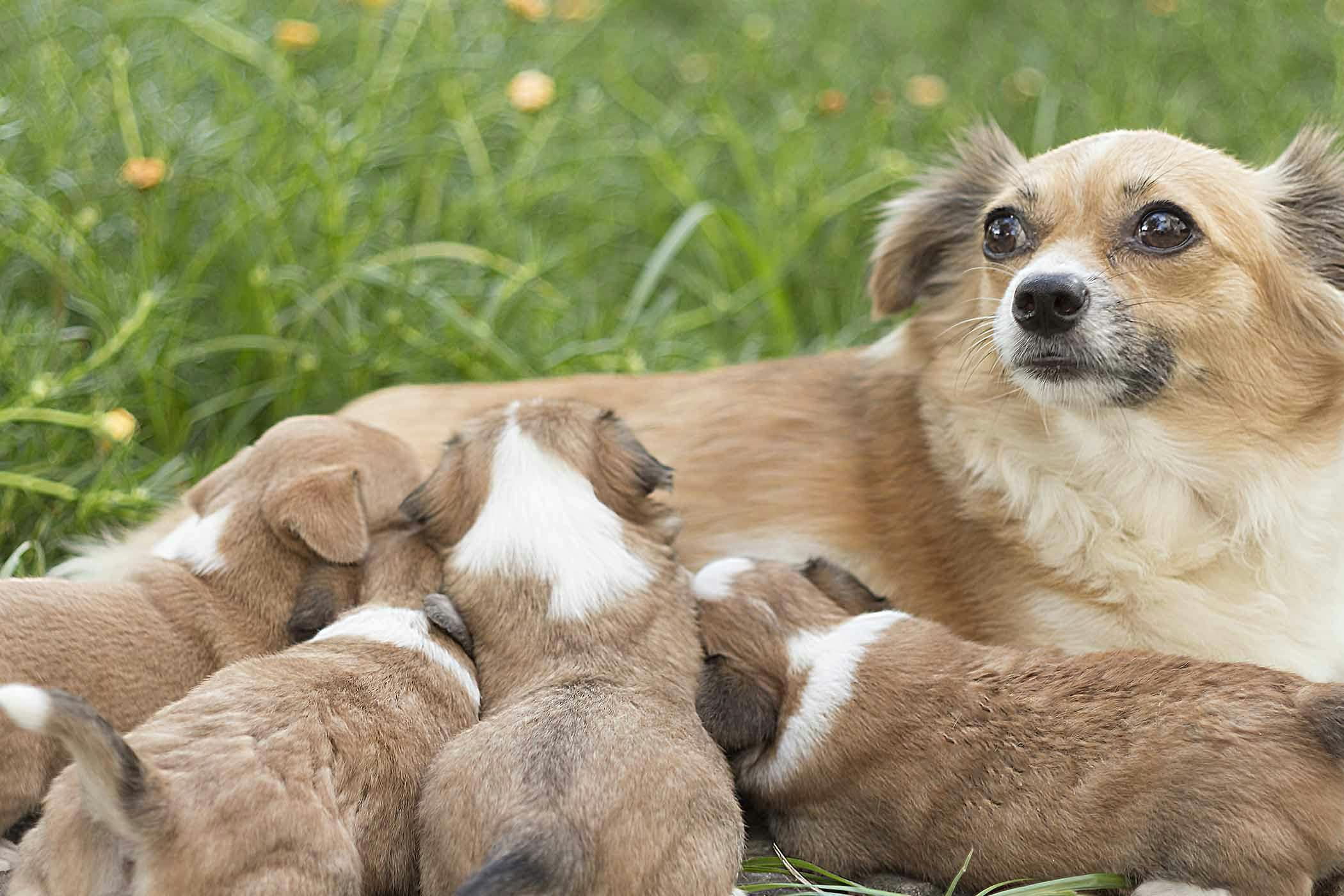If your dog is not pregnant but is leaking milk when squeezed, it could be a sign of a false pregnancy. This condition is caused by hormonal imbalances, often occurring after the dog’s first heat cycle.
It can cause swollen belly, moodiness, and lactation. Typically, the symptoms will resolve on their own within three weeks. However, if you are certain that your dog is not pregnant and she is experiencing milk leakage, it is advisable to consult a veterinarian to rule out any other potential underlying health issues.
Mastitis and cancer of the mammary glands are possibilities that require immediate attention.

Credit: wagwalking.com
Understanding False Pregnancy In Dogs
False pregnancy, also known as pseudopregnancy or phantom pregnancy, is a condition that affects female dogs. It occurs when a dog, even if not pregnant, exhibits signs and behaviors similar to those of a pregnant dog. This condition is often caused by hormonal imbalances, typically after the dog’s first heat cycle. While false pregnancy is a natural occurrence in dogs, it can cause discomfort and health issues for your furry friend. In this article, we will explore the causes, symptoms, and treatment options for false pregnancy in dogs. By understanding this condition, you can better care for your beloved canine companion.
Causes Of False Pregnancy
False pregnancy in dogs is primarily caused by hormonal fluctuations. After the dog’s heat cycle, her progesterone and prolactin hormone levels may remain elevated, leading to the physical and behavioral changes associated with false pregnancy. Some factors that can contribute to hormonal imbalances and false pregnancy include:
- Progestin-based contraceptives
- Irregular heat cycles
- Prolonged or intense mating activity
- Stress or anxiety
Symptoms Of False Pregnancy
Identifying the symptoms of false pregnancy in dogs is crucial for providing appropriate care. The signs of false pregnancy can vary between individuals, but common symptoms include:
- Enlarged mammary glands (breasts) and nipples
- Milk production
- Behavioral changes, such as nesting and mothering activity
- Restlessness and decreased interest in physical activity
- False labor and protective behavior towards objects
Treatment For False Pregnancy
If your dog is experiencing false pregnancy, there are several treatment options available to alleviate discomfort and manage the condition. These include:
- Monitoring: Keep a close eye on your dog’s mammary glands for signs of inflammation or infection. Contact your veterinarian if you notice any abnormalities.
- Comfort measures: Provide a comfortable and quiet space for your dog to rest. Consider using a heating pad or warm towel to relieve pain and swelling.
- Dietary adjustments: Adjust your dog’s diet to meet her nutritional needs during this period. Consult with your veterinarian for recommended changes.
- Medication: In severe cases, your veterinarian may prescribe hormonal medications to regulate your dog’s hormone levels and alleviate symptoms.
- Spaying: If your dog experiences recurrent false pregnancies or severe symptoms, spaying may be recommended. Spaying eliminates the possibility of future false pregnancies.
It’s essential to consult with your veterinarian for an accurate diagnosis and appropriate treatment plan for your dog’s false pregnancy. They will guide you through the process and ensure your dog’s health and well-being are prioritized.

Credit: www.newyorker.com
Potential Medical Conditions
If your dog is not pregnant but is producing milk when the breasts are squeezed, it could be a false pregnancy caused by hormonal imbalances. This can result in swollen belly, moodiness, and lactation, which usually resolves within three weeks.
However, it is recommended to consult a veterinarian for proper diagnosis and treatment.
Mastitis In Dogs
Mastitis is a potential medical condition that can cause milk production in dogs, even if they are not pregnant. It is an inflammation of the mammary gland tissue, which can result from an infection or injury. Common symptoms of mastitis include slight redness around the nipple, fever, palpable mass, discolored mammary gland, inflamed teats, loss of appetite, weight loss, and lethargy. If you notice any of these signs in your dog, it is important to seek veterinary attention immediately. Prompt treatment can help alleviate the discomfort and prevent complications.Mammary Gland Cancer
Another possible cause of milk production in non-pregnant dogs is mammary gland cancer. While it is more commonly seen in intact female dogs, both males and females can develop this type of cancer. If your dog is producing milk without being pregnant, it could be a sign of mammary gland tumors. Early detection is crucial for successful treatment, so make sure to have your dog examined by a veterinarian. They will conduct a thorough evaluation and may recommend additional tests, such as biopsies or imaging, to confirm the diagnosis and determine the most appropriate treatment plan.Other Possible Causes Of Milk Production
Apart from mastitis and mammary gland cancer, there are other potential causes of milk production in non-pregnant dogs. One common reason is pseudopregnancy, also known as a false pregnancy. This condition occurs due to hormonal imbalances, often after a dog’s heat cycle. Dogs experiencing pseudopregnancy can exhibit behavioral changes such as nesting, mothering activity, restlessness, decreased interest in physical activity, and aggression. They may also have swollen mammary glands and produce milk. Pseudopregnancy typically resolves on its own within three weeks, but if you have concerns about your dog’s well-being, consulting with a veterinarian is advisable. It is crucial to remember that milk production in non-pregnant dogs is not a normal occurrence and can indicate underlying medical conditions. If you notice milk coming out of your dog’s breasts when squeezed and you are certain she is not pregnant, it is essential to seek veterinary care for a proper diagnosis and appropriate treatment. Timely intervention can help ensure the health and well-being of your furry companion.Managing Milk Production In Dogs
If your dog is not pregnant and you notice milk coming out of her breasts when squeezed, it could be due to a false pregnancy or hormonal imbalances. This is a common occurrence and typically resolves on its own within three weeks.
However, if the issue persists or your dog shows other symptoms, it’s best to consult a veterinarian.
Preventing False Pregnancy
If you know for sure that your dog is not pregnant, but you notice milk coming out of her breasts when squeezed, she could be experiencing a false pregnancy. This is a condition that occurs due to hormonal imbalances, especially after your dog’s first heat cycle. It is important to prevent false pregnancy to ensure your dog’s well-being.
To prevent false pregnancy in dogs:
- Consider spaying your dog: Spaying eliminates the risk of false pregnancy as it removes the reproductive organs that cause hormonal fluctuations.
- Provide a balanced diet: Feed your dog a well-balanced diet that meets her nutritional needs. Avoid overfeeding, as excessive weight gain can contribute to hormonal imbalances.
- Keep stress levels low: Stress can worsen hormonal imbalances. Create a calm and stress-free environment for your dog.
Addressing Mastitis
In some cases, milk leakage in non-pregnant dogs may be a sign of mastitis, which is inflammation of the mammary glands. It is essential to address mastitis as it may indicate an underlying health issue.
If you suspect your dog has mastitis:
- Observe for symptoms: Look for signs such as slight redness around the nipple, palpable mass, discolored mammary gland, inflamed teats, loss of appetite, weight loss, and lethargy.
- Keep the affected area clean: Wash the affected nipples with warm water and gentle antibacterial soap to prevent infection.
- Apply warm compress: Use a warm compress on the swollen area to help reduce inflammation and promote milk flow.
- Consult a veterinarian: It is crucial to consult a veterinarian for a proper diagnosis and treatment plan. They may recommend antibiotics or other medications to address the infection or underlying cause.
Consulting With A Veterinarian
If you notice milk coming out of your dog’s breasts when squeezed and she is not pregnant, it is important to consult a veterinarian. They are trained professionals who can provide accurate diagnosis and appropriate treatment options.
During the veterinary consultation:
- Describe the symptoms: Explain in detail the signs you have observed, such as milk leakage, swelling, or changes in behavior.
- Provide medical history: Inform the veterinarian about your dog’s medical history, including previous pregnancies, spaying, and any other relevant information.
- Allow physical examination: The veterinarian may perform a physical examination to assess your dog’s mammary glands, check for possible infections or tumors, and evaluate overall health.
- Follow recommended treatment: Follow the veterinarian’s advice regarding treatment plans, medications, or any necessary procedures.
Remember, professional veterinary guidance is crucial in managing milk production issues in dogs. Regular check-ups and proactive measures can help maintain your dog’s health and prevent complications.

Credit: www.newyorker.com
Frequently Asked Questions On Milk Coming Out Of Dog Breast When Squeezed Not Pregnant
Why Is My Dog Leaking Milk If She’s Not Pregnant?
If your dog is not pregnant but is leaking milk, it could be due to a false pregnancy. Hormonal imbalances, especially after the first heat cycle, can cause this. It usually resolves on its own within three weeks. If you’re concerned, consult a veterinarian.
Can A Dog Get Mastitis Without Having Puppies?
Yes, a dog can get mastitis without having puppies. Mastitis can be caused by hormonal imbalances or even cancer of the mammary glands. If your dog is experiencing mastitis without nursing puppies, it is important to seek veterinary attention immediately.
What Are The Symptoms Of A Dog Having A Pseudopregnancy?
A dog with pseudopregnancy may show symptoms such as swelling of the belly and mammary glands, increased moodiness, lactation, nesting behavior, restlessness, decreased interest in physical activity, and sometimes aggression. They may also exhibit signs of false labor and guard toys or small objects.
How Do You Know If Your Dog Has Mastitis?
If your dog is not pregnant but is leaking milk, she may be experiencing a false pregnancy. This can happen due to hormonal imbalances after her first heat cycle. She may have a swollen belly, mood changes, and lactate. False pregnancies usually resolve within three weeks.
If you are concerned, consult your veterinarian for further evaluation.
Conclusion
If you notice milk coming out of your dog’s breasts when squeezed and she is not pregnant, it could be due to a false pregnancy. Hormonal imbalances, especially after the first heat cycle, can cause this condition. In most cases, the symptoms will clear up on their own within three weeks.
However, if you are concerned, it is recommended to consult with your veterinarian for further evaluation and guidance.


